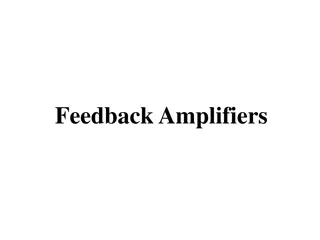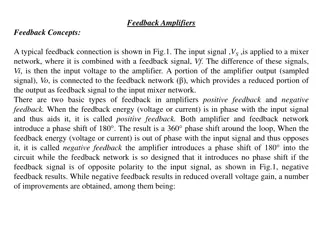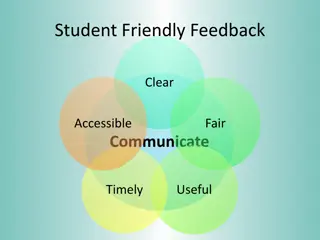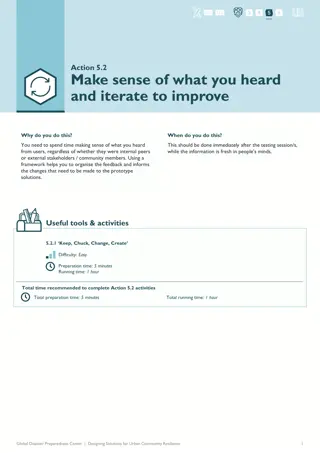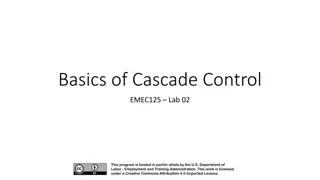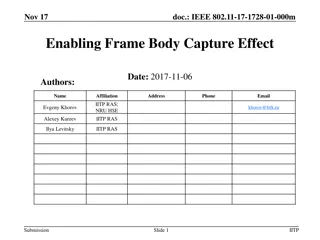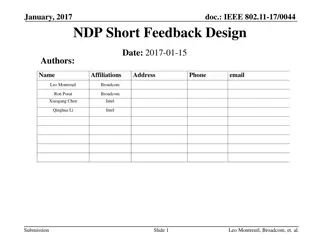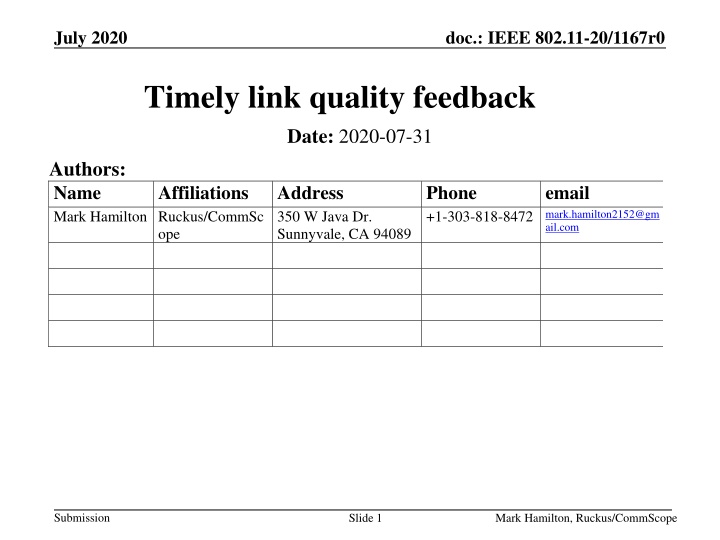
Improving Bi-Directional Link Quality in IEEE 802.11 Networks
In this document, Mark Hamilton from Ruckus/CommScope addresses the current issues with feedback mechanisms for link quality in IEEE 802.11 networks. The proposal suggests providing transmitters with real-time feedback on the remote peer's perception of received signal strength, aiming to enhance the understanding of transmit direction link quality. By improving bi-directional link quality metrics, the proposal aims for better performance, faster convergence, and enhanced decision-making in wireless networking configurations.
Download Presentation

Please find below an Image/Link to download the presentation.
The content on the website is provided AS IS for your information and personal use only. It may not be sold, licensed, or shared on other websites without obtaining consent from the author. If you encounter any issues during the download, it is possible that the publisher has removed the file from their server.
You are allowed to download the files provided on this website for personal or commercial use, subject to the condition that they are used lawfully. All files are the property of their respective owners.
The content on the website is provided AS IS for your information and personal use only. It may not be sold, licensed, or shared on other websites without obtaining consent from the author.
E N D
Presentation Transcript
July 2020 doc.: IEEE 802.11-20/1167r0 Timely link quality feedback Date: 2020-07-31 Authors: Name Mark Hamilton Ruckus/CommSc ope Affiliations Address 350 W Java Dr. Sunnyvale, CA 94089 Phone +1-303-818-8472 mark.hamilton2152@gm email ail.com Submission Slide 1 Mark Hamilton, Ruckus/CommScope
July 2020 doc.: IEEE 802.11-20/1167r0 Abstract A proposal is made to provide transmitters with real-time feedback on the remote peer s perception of received signal strength Submission Slide 2 Mark Hamilton, Ruckus/CommScope
July 2020 doc.: IEEE 802.11-20/1167r0 Problem Statement 1a Currently, in 802.11, the transmitter on a given association/link only gets indirect or delayed feedback on how well the peer receiver is hearing transmitted frames (for 2.4/5/6 PHYs): RCPI in (Re)Association response, probe responses (if requested), several radio measurement reports, RSNI in (Re)Association response, probe responses (if requested), several radio measurement reports, and in DMG for Directional Channel Quality request/report RSSI only in S1G Open-Loop Link Margin calculation ANPI only in some radio measurement reports Submission Slide 3 Mark Hamilton, Ruckus/CommScope
July 2020 doc.: IEEE 802.11-20/1167r0 Problem Statement 1b The receiver has information about the incoming link quality, from the transmitter s reported TX signal level, compared to the received signal level, local interference metrics, errors, etc. However, translating this to quality for the outbound link depends on poor assumptions: The links are symmetric, which they can be often, but not always, especially when beamforming is in use (which is becoming very common) Local interference at the peer will affect RSNI in unknowable ways, unless queried (and then, again, is delayed feedback) Trying to guess link quality from data rate adjustments is awkward and slow Submission Slide 4 Mark Hamilton, Ruckus/CommScope
July 2020 doc.: IEEE 802.11-20/1167r0 Problem Statement - 2 Note that for DMG/CDMG/CMMG, the transmitter gets immediate feedback on how well the peer receiver is hearing transmitted frames: In DMG/CDMG/CMMG TXVECTOR (LAST_RSSI) of all response frames is set to RCPI of the previously received frame Carried in PPDU header, delivered in RXVECTOR (LAST_RSSI) Used for beamforming decisions Better bi-directional link quality metrics for 2.4/5/6 GHz PHYs can result in higher performance, faster convergence on optimal parameters, better decisions about client transitions/steering, beamforming patterns, etc. Submission Slide 5 Mark Hamilton, Ruckus/CommScope
July 2020 doc.: IEEE 802.11-20/1167r0 Proposal, learn from DMG Use a similar immediate and constant feedback, to understand the transmit direction link quality Too late to add this to PPDU headers, like DMG did But, can add/negotiate additional BA information in BlockAck frames, without backward compatibility concerns Submission Slide 6 Mark Hamilton, Ruckus/CommScope
July 2020 doc.: IEEE 802.11-20/1167r0 Proposal, learn from DMG BlockAck frame format: The BA Information field contents are indicated by the BA Control bitmap, which has 7 reserved bits Add 2 bits to indicate presence of RSNI and RCPI fields, respectively, at the end of the BA Information Is this a backward compatibility issue? Do existing implementations assume the format of the entire BA Information field, per 9.3.1.8.x and existing BA Control bits? Submission Slide 7 Mark Hamilton, Ruckus/CommScope
July 2020 doc.: IEEE 802.11-20/1167r0 Proposal if backward compatibility issue Negotiate capability for signal strength indication in BlockAck frames, via the ADDBA Extension element (present in ADDBA Request and Response frames): Add two bits from the Reserved bits in the ADDBA Capabilities, to indicate support for these added fields in BlockAck frames. Submission Slide 8 Mark Hamilton, Ruckus/CommScope
July 2020 doc.: IEEE 802.11-20/1167r0 COMMENTS/FEEDBACK? Submission Slide 9 Mark Hamilton, Ruckus/CommScope





